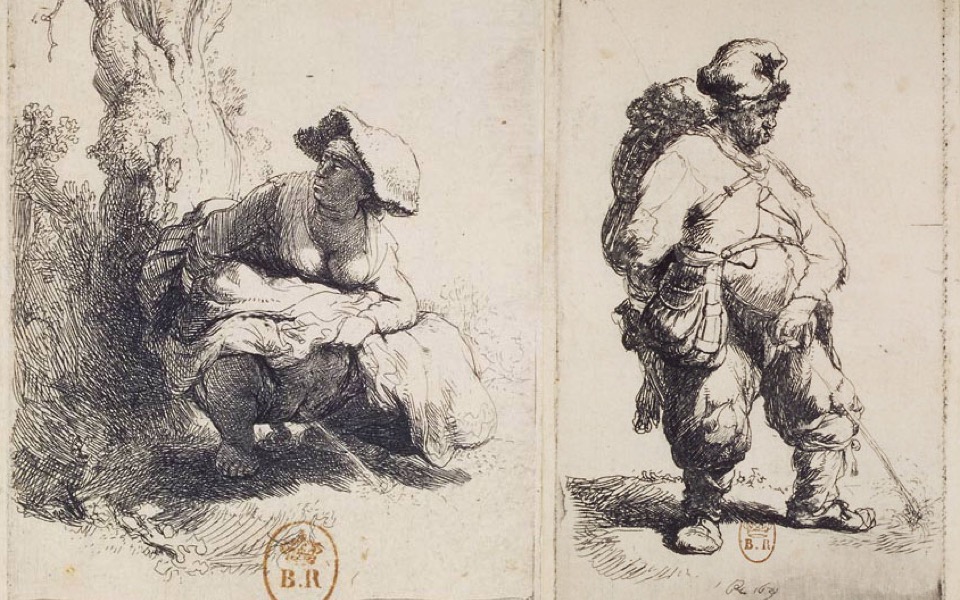Rembrandt’s Crucifixion (1631)

Rembrandt, Crucifixion (1631) Oil on canvas. Parish Church, Le Mas d'Angenais, France
Click image to enlarge.
This painting is little known in part because it hangs in a parish church in a small French town and was only re-discovered in the 1950's. It also makes scholars very uncomfortable. Not until 2009 did two art historians, Shelley Perlove and Larry Silver, note in a book on Rembrandt's faith that Christ's contorted face resembles the artist himself in an engraving, Self-Portrait with an Open Mouth, made the year before.
Click next thumbnail to continue

Left: Rembrandt's Crucifixion (1631), detail
Right: Rembrandt's Self-portrait with Open Mouth (1630) Engraving, detail rotated
Click image to enlarge.
A subsequent exhibition organized by the Louvre, Rembrandt and the Face of Jesus, now traveling the States, downplays their observation. A long excerpt from their book is included in the catalog as an independent chapter but it excises all reference to the similarity.1 Another contributor to the catalog, Lloyd DeWitt, notes the resemblance without comment while Blaise Ducos, given the responsibility to discuss the painting in depth, ambiguously notes that Rembrandt here brings "the divine figure to a personal level - through his face."2 She then discusses Christ's suffering in the image without further reference to Rembrandt.
Click next thumbnail
Rembrandt was clearly immersed in both the Christian and Jewish Kaballah, illustrating a cabbalistic treatise for a Jewish rabbi. A mystical outlook, though, could have been generated in many ways. It was secretly tolerated inside the Roman Church through the influence of figures like St. Francis and Nicholas of Cusa or hounded as heresy outside. In Holland practitioners should have found it easier to imitate the life of Jesus by interpreting biblical events allegorically. Christ to them was not just a historical figure but a living presence inside each of us. Practitioners act through imitation, from reading and through study of the arts; believers take on faith nonsensical stories as literal truth.
See conclusion below
This painting, from early in Rembrandt's career, states quite clearly that Rembrandt, whatever faith he might have adhered to publicly, followed the Inner Tradition inside his own heart. Rembrandt is Christ; Christ Rembrandt. The suffering which his spirit endures on the Cross is the unavoidable creative suffering of a great master. Besides, death and art are so closely associated that Christ's crucifixion is the iconic symbol in art for the completion of a masterpiece, the "nude male body of the artist". This is in keeping with the mystic phrase "As above, so below." We were created in the image of God so perfectly that everything in the cosmos finds its reflection inside the human body. Even the dark background, which indicates we are in the depths of his mind, is green, the color of fertility and creativity. Other artists like Dürer obviously identified with Christ. We have begun to show here how Leonardo, Michelangelo, Raphael, Titian and their followers did so as well. Once seen, Rembrandt's continuation of this tradition is no surprise though its discovery should change art history.
In making my argument above I failed to see the most important evidence: Rembrandt's signature. Please click on the link to read the short blog as an addendum.
More Works by Rembrandt
It can be difficult to explain why Rembrandt portrayed himself as a beggar. Here's what I think...

Rembrandt’s Self-portrait as A Beggar Seated on a Bank (1630)
Notes:
1. Larry Silver and Shelley Perlove, "Rembrandt's Jesus" in Rembrandt and the Face of Jesus (Philadelphia Museum of Art) 2011, pp.75-107
2. Lloyd DeWitt, "Testing Tradition Against Nature: Rembrandt's Radical New Image of Jesus" in Philadelphia, op. cit.,p. 111; Blaise Ducos, "The Impassibility of the Gods: Rembrandt and Christ" in ibid.,p. 185
Original Publication Date on EPPH: 31 Oct 2011. | Updated: 0. © Simon Abrahams. Articles on this site are the copyright of Simon Abrahams. To use copyrighted material in print or other media for purposes beyond 'fair use', you must obtain permission from the copyright owner. Websites may link to this page without permission (please do) but may not reproduce the material on their own site without crediting Simon Abrahams and EPPH.



